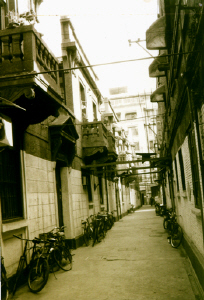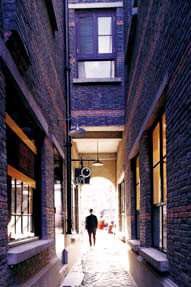
Some large longtangs inhabited nearly a hundreds or hundreds of households as cities within a city. In them there were grocery stores, snack shops, barber shops, hot water sellers, tailors and even small industries. "Longtang factory" was one special feature of Shanghai. The owners of these factories were mostly technical workers themselves, and with the help of three or four apprentices, careful design and fine workmanship, they could produce some very good and useful utensils and other items for daily use made out of scraps cast away by the big factories. Their products once played an important role in the small goods market in Shanghai. The present No. 8 Steel Works of Shanghai was actually set up on the basis of several longtang factories after 1949. The "longtang mansion" was another special feature of Shanghai. In old Shanghai, where public order was not good, robbery and kidnapping were not uncommon, and some of the wealthy men were afraid to show their wealth, so they did not build their mansions along the street, but preferred to build a longtang in front to conceal their mansion. The mansions were usually big and beautifully decorated inside but their outward appearance was similar to the other houses. This custom seemed very different from the West as well as from interior China.

Longtang was a product of Shanghai and belongs to the Shanghai people. It tells the story of Shanghai and reflects the culture, life-style and philosophy of the Shanghai people. There were many types of longtang houses, and every one was a part of the whole. Reading the Shanghai longtangs is like reading the social history of Shanghai and the Shanghai people. In recent years, Shanghai has been completing an area of l0 million square meters a year for new housing, but still 45% of the city’s popu1ation lives in longtangs. As the city is now undergoing a large-scale reconstruction, the longtangs of relatively good quality will be conserved and equipped with modern amenities, those of very poor condition will be demolished and those in-between will be reformed in different ways, such as preserving their appearance while making them suitable for modern living. In this period of great development and drastic change, it is meaningful and important to recall and discuss the relations between the Shanghai longtang, Shanghai people and Shanghai culture
Source: Chinesevoice.com
Editor: Feng Hui

